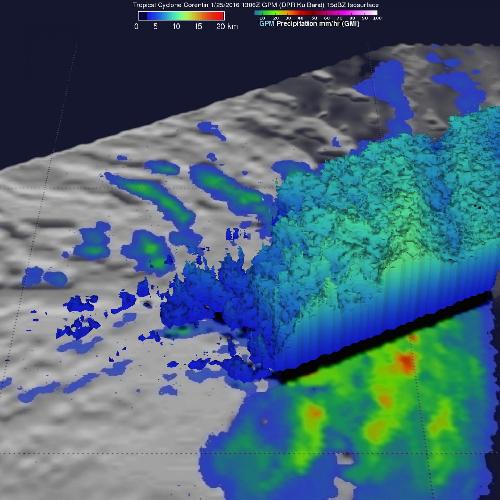Tropical cyclone Corentin was the first named tropical cyclone of 2016 in the South Indian Ocean. The GPM core satellite measured rainfall in the weakening storm.
Corentin caused little danger because its genesis, maturation and dissipation all occurred over the Southern Indian Ocean about equidistant from the distant shores of Madagascar and Australia. The storm never affected land areas.
The Global Precipitation Measurement or GPM core observatory satellite is co-managed by both NASA and the Japan Aerospace Exploration Agency. GPM flew over Tropical Cyclone Corentin on Jan. 25, 2016 at 1306 UTC (8:06 a.m. EST). High vertical wind shear was starting to take its toll on the increasingly disorganized tropical cyclone. Rainfall data was collected by GPM Microwave Imager (GMI) and Dual-frequency Precipitation Radar (DPR) instruments and showed that Corentin still contained some moderate to heavy rainfall in bands southeast of the exposed center of low level circulation. GPM's DPR measured precipitation falling at rates of up to 78.5 mm (3.1 inches) per hour in that area.
 On Jan. 25, 2016 GPM saw heaviest rainfall in Tropical Cyclone Corentin falling at rates of up to 78.5 mm (3.1 inches) per hour and most cloud tops were less than 7 km (4.3 miles). Credit: Credits: NASA/JAXA/SSAI, Hal Pierce
On Jan. 25, 2016 GPM saw heaviest rainfall in Tropical Cyclone Corentin falling at rates of up to 78.5 mm (3.1 inches) per hour and most cloud tops were less than 7 km (4.3 miles). Credit: Credits: NASA/JAXA/SSAI, Hal Pierce
3-D measurements by GPM's Radar (DPR Ku band) showed that most storm tops in the elongated tropical cyclone were reaching heights of less than 7 km (4.3 miles).
Strong northwesterly vertical wind shear weakened the storm and elongated the circulation pushing the clouds associated with the low to the southeast of the center. Vertical wind shear was between 20 to 30 knots (23 and 34.5 mph/37 and 55.5 kph). In addition to the wind shear, Corentin's remnants had moved into waters too cool to maintain a tropical cyclone. A tropical cyclone needs sea surface temperatures of at least 26.6 degrees Celsius (80 degrees Fahrenheit) to maintain intensity. Sea surface temperatures in the vicinity of the low are between 24 and 26 degrees Celsius (75.2 and 78.8 degrees Fahrenheit).
On Jan. 26, 2016 at 0030 UTC (Jan. 25 at 7:30 p.m. EST), Corentin had weakened into a remnant low pressure area. The low was located about 1,228 nautical miles south-southeast of Diego Garcia, near 26.5 degrees south latitude and 79.8 degrees east longitude. The Joint Typhoon Warning Center noted that Corentin's remnants have a low chance to re-develop in the next day or two.
source: NASA/Goddard Space Flight Center